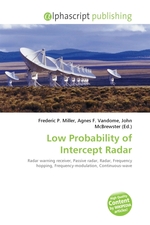Low Probability of Intercept Radar
Frederic P. Miller, Agnes F. Vandome, John McBrewster
бумажная книга
High Quality Content by WIKIPEDIA articles! A low-probability-of-intercept radar is designed to be difficult to detect by passive radar detection equipment while it is searching for a target or engaged in target tracking. This characteristic is desirable in a radar because it allows finding and tracking an opponent without alerting them to the radar's presence. Ways of reducing the profile of a radar include using wider-frequency bandwidth, frequency hopping, using a frequency-modulated continuous-wave signal, and using only the minimum power required for the task. Using pulse compression also reduces the probability of detection, since the peak transmitted power is lower while the range and resolution is the same. Constructing a radar so as to emit minimal side and back lobes may also reduce the probability of interception when it is not pointing at the radar warning receiver. However, when the radar is sweeping a large volume of space for targets, it is likely that the main lobe will repeatedly be pointing at the RWR. Modern phased-array radars not only control their side lobes, they also use very thin, fast moving beams of energy in complicated search patterns.
Данное издание не является оригинальным. Книга печатается по технологии принт-он-деманд после получения заказа.


